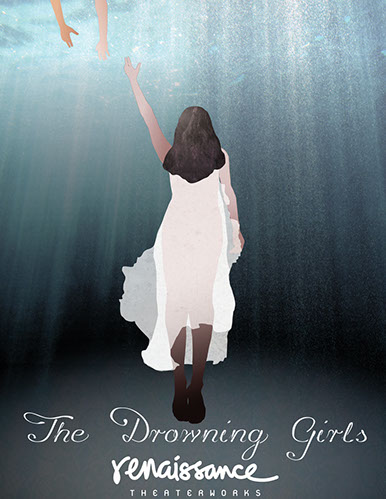

For a creepy Halloween thriller, one would be hard-pressed to find a better choice than The Drowning Girls, the season opener by Milwaukee’s Renaissance Theaterworks.
As one enters the dimly lit black-box theater, the air is soon filled by the strains of a church organ. One is immediately launched into a haunting, chilling tale of three women who died at the hands of their husbands. The stage is set with a row of three glossy, white claw foot bathtubs. Behind them are seen three gauzy, equally white wedding dresses and veils. Behind each tub and wedding dress is a set of heavy, Victorian-style layered curtains. Each will play an important role in the events to come. As the ghost story begins, each woman emerges from below water in the tub. The first one, Beatrice (Bessie), sputters and coughs before she can begin her sad life story. She is dressed in a plain, white smock. Later, she and the others don their wedding dresses. Bessie’s dramatic “entrance” focuses the audience’s attention immediately, as we are riveted by the story told by this simple-minded, dripping-wet girl.
The Drowning Girls was written by Canadian trio Beth Graham, Charlie Tomlinson, and Daniela Vlaskalic. It is based on the real-life story of three women in the early years of the 20th century, who were dubbed in the newspapers as “Brides of the Bath.” All three women died mysteriously between 1912-1914. Once the case was unraveled, a man went to the gallows for his ghastly crime.
The play opened Off-Broadway in 2013 in a production by Sun Strange Theater. Among the play’s three actors was Kate Danson, daughter of Ted Danson (TV’s “Cheers,” “CSI.”) In the Renaissance version, all three actors are relatively new faces to Milwaukee audiences. Each of them has a chance to shine as they take on multiple roles, which include life insurance salesmen, family members, pets, and even the killer. Most of the time, though, each actor creates a unique portrait of one of the murdered women.
Bessie (marvelously played by Elyse Edelman), the first one to appear, is incredulous, sad, angry, and hurt. She cannot understand why her husband, the man who swore to love, honor and protect her, could be so cunning and cruel. Nobody ever mentioned that. In Victorian times, girls were raised from birth to learn the skills of being a “good wife.” In this repressed era, any other path would be discouraged or even snuffed out by sensible mothers and stern fathers. As we meet the other two women, the spunky Alice (Susie Duecker) and older, world-weary Margaret (Marcee Doherty-Elst), similarities begin to emerge. All three women married quickly, often within two weeks of meeting their mate. Each woman was charmed by aspects of his character (“he was a devil,” snickered Alice). Tellingly, each woman reveals a lot about herself as she names her intended’s positive attributes.
Part of the play is told in a sing-song style, with actresses checking off a list. In such segments, they do not talk in full sentences. Director Mallory Metoxen has orchestrated these sections well, but they need to flow more smoothly. They probably will do so in subsequent performances. It’s a lot to ask of these actors, who have much stage business to do. They don their wedding dresses and keep hopping in and out of their tubs. Also, they often have water dumped on their heads, either from showerheads or pitchers that they fill from their bathtubs. The pitcher pouring reminds one of baptism. Indeed, these girls seem free from sin (unless one considers guilelessness a sin). As a prosecutor attempts to debunk the notion of how someone could be killed in a bathtub without anyone below hearing screams, shouts or splashing, a re-enactment is performed in court. (The play has some humor, and this is one of the funnier scenes.) The play contains a fair amount of social commentary, too. If the women did not marry, they shuddered at the alternative: life as a spinster, who would forever be a burden to her family. Unmarried ladies, they agreed, were shunned, unwanted, forgotten. Even as fiancées, they noticed that passersby were more likely to smile and nod at them as they walked, secure in the arms of a man. On a man’s arm they felt important, special, envied. It was as if society itself was partly responsible for tossing these women at a man with a mission and a monstrous heart.
